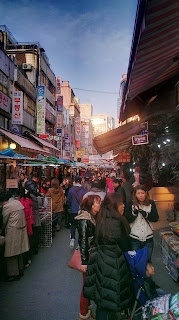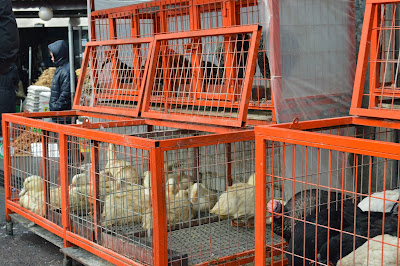The other weekend, with Sarah's parents in town, we made the trip up to the most dangerous place on Earth...the Demilitarized Zone. Running the length of the 250 kilometer border between North and South Korea, and about 4 kilometers wide (2km to the north and 2km to the south of the Demarcation line), you'll find over a millions of land mines, barbed-wire fence and armed soldiers on both sides filled with animosity towards one another.
The tension was palpable as we arrived at the first checkpoint along the Imjin River on our way to the DMZ. Barbed wire fences lined the river, since it directly connected North and South Korea with military outposts at about every 100yards (I slept most of the way up because we had to wake up around 5:30am so I didn't get any pictures of this part of the trip). The Imjin River is also knows as the "River of the Dead" because of the many dead North Koreans found floating down it during the famine up North in the 90s.


We eventually made it to Camp Bonifas who's motto is "In Front of Them All," where we watched a brief introduction of Panmenjeom and the Joint Security Area (JSA) and had to sign waivers saying that we understand that there's a possibility of being shot during this trip (generally speaking). From that point, we were led by a US solider back onto the buses and up to the Demarcation Line, which is the actual boundary line drawn when the armistice agreement was signed. There was a strict no photo policy and the tension grew expotentially as we drove down the "most dangerous road on earth" through anti-tank walls, mine fields and barbed-wire lined streets. We arrived at Conference Row where the soldier in charge of our tour was much more firm and direct (if he could get anymore firm or direct) in what to do, how to do it and, most importantly, what not to do to avoid provoking the North.
A couple points about the trip: There's a strick dress code required for the tour because the entire time you are at Conference Row where you can see North Korea and it's troops, you are being watched. They are looking for any suspicious actions or things they can use as propaganda against the outside world. While we were there, a North Korean soldier took out his binoculars and checked us out a few times. It was a tense situation to say the least but definitely a memorable one.

 |
| Mrs. Brennan is "safe" in South Korea...Sarah isn't so lucky in North Korea |
 |
| Taking my chances in North Korea |
 |
| Mr. Brennan cautiously leaving the Korea |
After making it out of the tension filled Conference Row safely, our next stop was to the Dorasan Train Station which use to carry materials to the Kaesong Industrial Complex to the north and finished goods back down to Seoul. North Korea closed railroad access into their country in 2008 but the newly restored station still stands. It put things into perspective a little though, that South Korea is basically an island and if the countries were to be unified again, the possibility of taking the train from South Korea to Western Europe is very much possible. For now though, you can only leave the country by plane or boat.
 |
| Anyone want to go to Pyeongyang? |
 |
| The Trans Eurasian Railway Network |
After lunch we went to the Third Tunnel, which is actually what the names states. South Korea discovered four tunnels that the North had dug under and across the DMZ into South Korea. Though they found four of them, there are believed to be at least 10 total tunnels from the North to the South. North Korea claimed that these tunnels were used for mining coal but there's no coal in that part of Korea. So, to reinforce their claim, as the N. Korean soldiers retreated from the tunnels, they painted the tunnels black so it looks like there was coal down there.
The tunnel was about 240 feet underground and about a mile long. Again, no cameras were allowed down there but it was quite impressive and unnerving at the same time.
 |
| Third Tunnel Entrance |
Our last stop on this USO sponsored trip was to the Dora Observatory where you can get a clear look at North Korea and it's propaganda village, Kijong-dong. The funny thing about this N. Korean village is that it's not a "real" village, meaning that no one lives there and a lot of the windows on the houses and buildings are painted on. There is a military base right at the observatory so pictures were limited but it was cool seeing N. Korea from afar with the provided binoculars.
 |
You can kind of see the N. Korea Propaganda Village
and it's huge flagpole. Either way, there's North Korea. |
 |
| Our transportation for the day, thank you Koridoor and USO!!! |
This USO led trip was one of the highlights of being in Korea so far. If you make it out to Korea for any reason, make sure you take one of these trips. It's an eye opening, tense, anxiety filled and exciting experience all wrapped up into about 10hours of your day. If you made it this far into the post...
Did you know...that 2010-2013 marks the 60 year anniversary of the Korean War. Also knows as the forgotten war, almost 2 million civilians and 1 million troops lost their lives in this three year war. What surprised me is that when the armistice was signed in 1953, no one from South Korea was present. While the communist forces offered a cease-fire, the South Koreans were pushing for unification, not a stalemate, thus there was no South Korean representation at the sining of the armistice.

















































